
Michael D. Mehta, Thompson Rivers University
In February, extreme weather events highlighted the fragility of the Texas electrical grid. A deep freeze left millions without power, and dozens of people died. President Joe Biden declared a state of emergency and ordered that federal assistance be made available.
As Texans’ demand for electricity soared, utility operators revealed how poorly prepared they were for extremely cold weather. The grid failed in a spectacular fashion and showcased how de-regulation can sometimes backfire.
Read more: How the Texas electricity system produced low-cost power but left residents out in the cold
Such scenarios are likely to grow in frequency and intensity as the impacts of climate change increasingly threaten infrastructure.
Renewables not responsible
Some Republican politicians falsely suggested that renewable energy was responsible for the widespread power outage. Fanning the flames of a raging culture war, they pointed at ice-covered wind turbines and solar projects instead of the frozen natural gas wells and low pressure in pipelines that created a supply shortage.
Natural gas contributes to 51 per cent of electricity production in the state, with solar and wind having a combined total close to 30 per cent. In the winter months in Texas, wind produces only 10 per cent of the total.
One way to improve the reliability and resilience of critical infrastructure is to increase the number of high voltage power lines and their maximum reliable capacity between jurisdictions. For example, there are currently 37 major transmission lines between the United States and Canada. According to the Canadian Electricity Association:
Every Canadian province along the U.S. border is electrically interconnected with a neighbouring U.S. state or states, with many provinces boasting multiple international connections. The result of the integrated Canada-U.S. electric grid is a flexible, reliable and secure grid on both sides of the border.
By contrast, Texas’s grid is isolated by choice and is not interconnected with other states. In 1935, Texas chose to avoid federal regulatory oversight and to remain “islanded.” Clearly, this decision came with a cost, and it now makes sense to rethink it.
Grids: Expensive and high maintenance
Maintaining grid infrastructure is expensive. In a 2015 report on grid modernization, the U.S. Department of Energy cites a study claiming that it could cost utility companies up to US$2 trillion by 2030 just to maintain current levels of service reliability.
Failing to adequately maintain grid infrastructure can be devastating to companies too. California-based utility giant PG&E declared bankruptcy in January 2019 when lawsuits emerged against the company for wildfires ignited by sparks from their power lines.
Ice storms can also wreak havoc on critical infrastructure. In January 1998, electrical transmission and distribution infrastructure collapsed in Montréal, Ottawa, other parts of Eastern Canada and the U.S.. Systems designed to be interdepedent failed simultaneously and knocked out electricity, telecommunications and transportation networks.
Traditional grids suffer from line losses between generating stations and end users. Line loss is the amount of electricity lost during transmission and distribution across an electric grid.

Longer distances between power plants and end users lead to larger line losses, which can reach as high as five per cent. Although this number may seem trivial, the energy lost annually from traditional electricity grids exceeds the energy in gasoline used by vehicles.
On a global basis, electrical grids are also exposed to cybersecurity threats that may compromise sub-stations and power plants. Utility companies must be more vigilant of these threats.
Microgrids: Next generation
An alternative to expanding existing grid infrastructure is to shift towards smart microgrids at the community level. A microgrid is a local network of generators, often combined with energy storage. It can be disconnected from a large (macro) grid network easily, if required.
Such systems can increase reliability and drive down carbon emissions when renewable energy is used. When combined with smart meters that reconcile inflows and outflows of electricity, microgrids provide real-time energy data. When a microgrid goes down, it only affects the local region and not an entire state or province.
Because of their scalability and flexibility, microgrids may be less expensive to build when compared with energy mega projects and their associated transmission and distribution infrastructure. But for this shift to succeed, interconnection standards need to be developed to optimize a two-way flow of electricity.

Microgrids have the added benefit of being able to use a large percentage of existing wiring within communities to contain costs. Additionally, they may fit better with the wants and needs of communities, generate local employment opportunities, lower consumption of electricity and take advantage of regional energy sources.
That said, research on various business models for them is still evolving, and work to make microgrids more secure from hackers is proving to be a challenge.
Monetizing renewable energy trading
Market mechanisms including peer-to-peer energy trading based on blockchain technologies like Bitcoin can be used within microgrids to track transactions and to increase market penetration. This has been demonstrated in Australia where owners of household solar arrays were able to buy and sell energy at an agreed upon price using real-time data.
Read more: How blockchain can democratize green power
When combined with a strategy to increase the adoption of electric vehicles, microgrids can take advantage of vehicle-to-grid technology by using energy stored in batteries of vehicles to reduce peak demand.
De-gridding and setting up a microgrid is challenging, as I learned in 2013 when I pushed to disconnect Gabriola Island from the provincial grid run by BC Hydro. By co-founding a solar non-proft called GabEnergy I was able to move the community in that direction somewhat. But provincial legislation granting the utility company exclusive rights in the region killed anything more ambitious.
Although microgrids have a lot of potential, they still face some challenges before they achieve wide-scale support.
Energy storage remains expensive. The cost of lithium ion batteries has dropped to about US$175 per kilowatt hour (kWh) of storage in 2019 from US$1,200 per kWh in 2010. But many industry experts say the cost must fall below US$100 per kWh to be competitive.
That said, other storage options exist, including small-scale pumped hydro, compressed air, and flywheel technology.
There are also several financial challenges, given the absence of a long track record. So far, investors have been reluctant to support microgrids, but this may be shifting. Schneider Electric is now partnering with investors to focus on microgrids to offer a hedge to companies who want longer term security with respect to the price they pay for electricity.
Legislation challenges also represent a barrier, and new regulatory frameworks and standardization are essential. Work to improve electrical codes for interconnecting with other grids will ensure safe operation of microgrids. Additionally, governments need to recognize that this approach can provide critical infrastructure to lower-income communities and regions most likely to be impacted by climate change. Microgrids represent a form of climate change adaptation.
In short, climate change represents a significant threat to electrical utilities and the communities they serve. It also offers the greatest opportunity for innovation, community development and risk minimization.
Smart microgrids are a leap forward in how we generate, transmit and consume electricity. We have the potential to make grid failures like what happened in Texas a thing of the past.
Michael D. Mehta, Professor, Department of Geography and Environmental Studies, Thompson Rivers University
This article is republished from The Conversation under a Creative Commons license. Read the original article.


